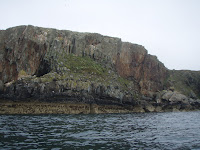Sophy gave me a lift down to the Outdoor Centre, and the boat was re-packed and on the water by 0840. I had been a bit concerned that the skeg box might take up so much space in the aft tank that some kit or supplies would need to be jettisoned, but in the event everything fitted, including Justine's marvellous
trolley.
We are on
springs, and the flood tidal stream is at its strongest at this time of day, so I stood out to sea, paddling hard south-west to ferry-glide beyond the worst of the race at Penrhyn Mawr. The three tide races to the west of Holy Island (Penrhyn Mawr, South Stack, and North Stack) have a
considerable reputation in the sport, but today they were very well behaved in the offshore wind.

This photo of South Stack probably looks like any other seaside shot on a sunny day to most of you, but if you have a whitewater background, read the water carefully...
By the time I was round North Stack and starting to cross Holyhead Bay, I was exposed to a much greater fetch and the sea state was quite a bit higher. Handling the boat felt less like paddling than weightlifting, and there was a lot of water coming over the bow. In addition, there are 18-or-so ferry movements into and out of Holyhead each day, many of which are fast cats, so the danger of collision is always there to stop one from getting bored. By the time I reached Carmel Head, the seas were breaking in wind-against-tide conditions and I had to make a choice between standing off (more favourable tidal stream but worse sea state) or standing close in (less sea state, but fighting an eddy).
Gradually the Wylfa nuclear power station drew abeam, and the most exciting sea state of the day arrived, generated by the wind-over-tide conditions on the open coast meeting the eddy issuing from the west side of Cemaes Bay. I was glad to arrive at the shelter of the inner bay, pull the boat ashore, and break out some lunch.

Chatting with passers-by over a mug of tea, I learned of the recent renovation of the
Charles Henry Ashley, a rowing lifeboat built in 1907 and now lying on a mooring in the inner harbour. This 5.5 ton non-self-righting vessel was crewed by a coxswain, second coxswain, bowman, and twelve oarsmen, who must have supplied brawn and heroism in equal measure. Cemaes no longer has its own operational lifeboat, but the numbers of people involved in the dedication ceremony, in May this year, speak volumes of the pride still felt in this part of the village's history. For many of our small coastal communities, the
volunteer lifeboat is a central and defining institution.
The met department at RAF Valley kindly briefed me on tomorrow's weather, and it was clear that paddling to the Isle of Man would not be feasible until these easterlies have blown over.
Dave Williams, formerly the harbourmaster here, readily and kindly agreed to let me park the boat at his cottage, and offered much-needed changing facilities, thus protecting the public from a hitch-hiker in skin-tight black rubber - surely, in these times, the greatest risk of the day.
Returning to a welcome berth chez Sophy, I was immersed once again in the life of RAF Valley: fast jet training, helicopter search & rescue, and all the familiar management complexities of any large organisation running a safety-critical operation.



















